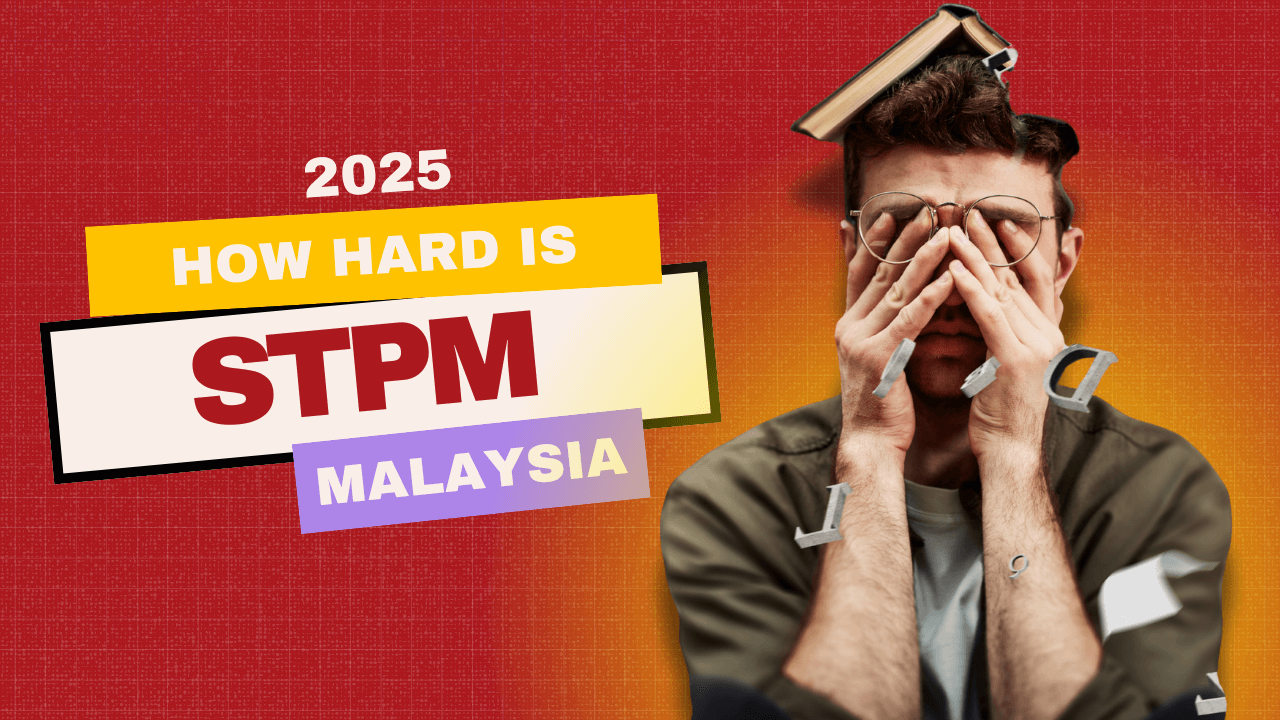How Hard Is STPM? Tips, Myths & Student Experiences
July 07, 2025
Mehmil

STPM – Tough, Unfair… or Worth It?
"STPM is the hardest exam in Malaysia."
You’ve probably heard that line before! Maybe from a teacher, a senior, or a cousin who looked emotionally drained just mentioning “Pengajian Am.”
So… how hard is STPM really? Is it truly worse than A-levels? Is it only for straight-A students? Or are these just exaggerations passed down like horror stories?
Let’s be honest: STPM is tough. It’s not just academically demanding. It can also test your mental health, time management, and motivation.
Between school-based assessments (SBA), three rounds of centralized exams, MUET stress, and UPU competition, Form 6 students are under real pressure.
But here’s the other side of the story: thousands of students survive STPM every year and many thrive. Some make it to public universities, others use their results to go abroad.
It’s not about being a genius; it’s about being strategic, resilient, and well-prepared.
In this article, we’ll break down:
- What makes STPM challenging
- Common myths vs reality
- Real student experiences
- Study tips and motivation strategies that actually work
So if you’re wondering whether STPM is right for you, or you’re already in Form 6 and just need a little support, you’re in the right place.
Common Challenges Faced by STPM Students (Straight from Those Who Lived It)

STPM isn’t impossible, but it’s definitely not easy either.
Many students find themselves overwhelmed by the tough grading, university-style assessments, and the pressure of performing over three semesters.
So if you’re asking, “Why do people fail STPM?” — the answer isn’t that they’re not smart. It’s that they weren’t prepared for the pressure that comes with Form 6 life.
Here are some of the biggest challenges Form 6 students say they face (and why some even drop out or struggle to pass):
1. Semester 1 Is the Real Trap
Many students walk into Form 6 thinking STPM is just an extended version of SPM. That’s the first mistake.
The reality? STPM requires deeper understanding, better time management, and totally new study techniques and Semester 1 often hits the hardest.
2. Adapting to Independent Learning Is Harder Than Expected
STPM doesn’t spoon-feed you. There’s less hand-holding, more self-study, and teachers may expect you to already know how to revise, organise notes, and pace your progress.
3. Kerja Kursus (SBA) Is No Joke
Balancing coursework like Pengajian Am projects alongside your regular classes and revision schedule is mentally exhausting.
4. No Official Textbooks = Confusion
Unlike SPM, STPM doesn’t provide official textbooks. You’ll have to rely on reference books (like Ace Ahead or Success) and your teachers’ advice, which isn’t always consistent.
5. Science Stream? Expect a High Dropout Rate
If you’re taking Science subjects, expect smaller classes and fewer classmates by the end.
This speaks to how intense the Science stream is, especially when students are still adjusting to the pressure of Form 6 life.
Coping With Pressure: How to Survive STPM (According to Real Students)
If you ask STPM seniors what the hardest part of Form 6 is, most won’t say the syllabus. They’ll say it’s the mental load; the pressure, the comparison, the fear of failing. And the truth is, almost everyone feels it at some point.
But here’s the good news: plenty of students have been through it and survived and they’ve got advice worth hearing.
It’s okay to struggle — we all did.
Burnout and mental health issues in STPM are common and that doesn’t make you weak. The key is not pretending it’s fine when it’s not. Talk to someone. Rest when needed. Reset.
Time-blocking saved me.
Don’t try to study 10 hours straight, it doesn’t work. Use apps like Notion, Forest, or a planner to break your day into chunks. It keeps you sane and helps you avoid burnout.
Talking to my classmates made a big difference.
STPM can feel isolating, especially when others are in Matrikulasi or Foundation. But your classmates are going through the same thing. Find your tribe, even a group chat can make a huge difference.
One small break a day = sanity.
Mental rest isn’t wasted time. It’s part of surviving STPM. Short breaks, hobbies, or just sitting in silence can go a long way in helping you recharge.
Online communities helped me not feel alone.
Reddit, Discord, Telegram, you’ll find peer support groups filled with STPM students helping each other stay afloat. When things feel too heavy, lean on someone who’s been there.
Best Ways to Study for STPM
Let’s be real, you can’t “wing it” in STPM. This isn’t like SPM where last-minute revision might get you by. With STPM’s modular format, the only way to survive (and score well) is to study smart — not just hard.
We asked successful STPM students study tips for STPM and what really worked for them. Here's what they swore by:
1. Past Year Papers = Your Best Friend
Nearly every high-scorer will tell you the same thing: if you’re not doing past year STPM papers, you’re missing out. Focus on the marking schemes and learn how questions are structured.
✅ Tip: Prioritize Semester 1 and 2 past papers early, so you’re not cramming later.
2. Ace Ahead = Gold Standard
When it comes to STPM reference books, Ace Ahead is the go-to. It’s clear, concise, and aligned with the syllabus. Many students also use the Success series for extra exercises, especially for subjects like Pengajian Am, Biology, and Maths T.
✅ Other helpful books: Pelangi, Sasbadi, Penerbit Ilmu Bakti (for BM-based content)
3. Use Flashcard Apps to Boost Retention
Apps like Anki use spaced repetition, ideal for memorizing definitions, terms, or chemistry equations. It’s a game-changer for visual learners and anyone short on time.
4. Stick to a Weekly Revision Schedule
Consistency > Cramming.
Set up a weekly study plan using tools like Google Calendar or Notion. Break subjects into small parts. Even 2 focused hours a day adds up.
Try the “3-2-1” rule:
→ 3 hours for tough subjects
→ 2 for moderate
→ 1 for revision or light reading
5. Exchange Notes with Friends
Whether it’s in-person or through WhatsApp groups, note exchange and mini-group discussions work well. You’ll cover more ground, fix weak spots, and maybe even enjoy the process.
UPU Competition: The Hidden Pressure
If you’re taking STPM, chances are your ultimate goal is to enter a public university through UPU. And while STPM is fully recognised for UPU admission, here’s the truth:
Just passing isn’t enough — you’ll need a high CGPA to compete.
Why Is It So Competitive?
Public universities in Malaysia (especially top ones like UM, UKM, and USM) receive thousands of applications each year, and UPU placement is purely merit-based for STPM students. That means:
- Your CGPA from STPM (on a 4.00 scale) plays the biggest role
- Your co-curricular score (10% of total) also counts
- Courses like Medicine, Dentistry, Pharmacy, Law, and Engineering have extremely limited seats
Even a CGPA of 3.50 might not be enough for high-demand programmes
How Does UPU Calculate STPM Results?
UPU uses a standardized CGPA + co-curricular formula. While exact weighting can vary slightly year to year, here’s the general idea:
| Component | Weight |
|---|---|
| STPM CGPA (max 4.00) | 90% |
| Co-curricular activities | 10% |
Your STPM CGPA is based on your best four subjects, including Pengajian Am.
What If I Don’t Get In?
You’re not out of options. Many STPM students:
- Apply to private universities (often with tuition fee waivers)
- Consider overseas universities. STPM is equivalent to A-levels and accepted in the UK, Australia, NZ, Singapore, and more
- Pursue credit transfer or twinning programmes
Need help with your UPU application?
👉 Read our 2025 UPU Application Guide for STPM students
Common Myths About STPM — Debunked

You've probably heard a lot of stuff like “Only students who can’t afford private college take STPM” or “It’s impossible to survive Form 6.”
Spoiler alert: Most of that isn’t true.
Let’s clear the air.
❌ Myth 1: “STPM is only for students who can’t afford private uni”
Sure, STPM is government-funded and budget-friendly but that doesn’t mean it’s a “last resort.”
Many students choose STPM because:
- It’s recognised by all public universities
- It’s accepted by top universities overseas
- It offers a solid academic foundation
💡 Fact: Some top-scoring SPM students prefer STPM over Matrikulasi or Foundation because they want a more structured, exam-based path.
❌ Myth 2: “STPM is harder than A-level”
This one’s tricky as both STPM and A-levels are tough, just in different ways.
- STPM has a modular exam system (3 semesters) and includes School-Based Assessment (SBA)
- A-levels are mostly final exam-based
- STPM is fully government-monitored and uses strict grading
So is it harder? Not necessarily. It depends on your learning style.
❌ Myth 3: “STPM is outdated”
Not true at all! STPM underwent a major revamp in 2012 and is now modular, includes coursework, and is benchmarked against international standards.
Plus, the exam board (MPM) still collaborates with the University of Cambridge to ensure its quality.
In short: It’s not your parents’ STPM anymore.
❌ Myth 4: “Nobody takes STPM seriously in 2025”
Actually, STPM remains one of the most respected pre-university qualifications in Malaysia and it’s still one of the main routes into public universities via UPU.
Students use it to apply not just locally, but to the UK, Australia, Singapore, and more.
So yes, in 2025 and beyond, STPM is still very much relevant.
(Read: Form 6 vs Foundation: Which is better?)
Wrap Up
So how hard is STPM, really? The truth is, it is challenging.
But many students have walked this path and succeeded. Some even say it changed the way they approach learning and life.
TPM success doesn’t mean straight As or perfect CGPAs. It looks like consistency, progress, and learning how to manage your time, emotions, and priorities.
If you’re aiming for public university entry or an affordable, globally recognised pre-university programme, STPM Malaysia is a solid choice. It’s not for everyone, but if you stay focused and seek support when needed, you’ll get through it.
Frequently Asked Questions
1. Is STPM harder than A-level?
STPM and A-level are both rigorous pre-university programmes. STPM is often seen as tougher due to its strict marking and modular exam format, but it's also more affordable and government-supported. Both are recognised internationally, making them strong options depending on your learning style.
2. Why do students find STPM stressful?
STPM stress comes from its demanding structure, three semesters, ongoing assessments, and high expectations. Students juggle school-based projects (SBA), centralised exams, and a tough CGPA scale.
3. Can I succeed in STPM without tuition?
Yes, success in STPM is possible without tuition if you're disciplined and consistent. Use STPM past year papers, form a study group, and rely on trusted reference books like Ace Ahead. Strong self-study habits matter more than extra classes.
4. What is the best way to prepare for STPM exams?
The best way to study for STPM is through active recall and past-year paper drills. Stick to a time-blocking schedule, revise using books like Ace Ahead or Success, and join peer discussions. Understanding the STPM exam format helps reduce last-minute stress.
5. Is STPM worth it in 2025?
Absolutely! STPM Malaysia 2025 is still one of the most cost-effective, merit-based ways to enter public universities. If you're academically driven and want a qualification that's recognised both locally and globally, it’s a smart choice.
6. How competitive is UPU for STPM students?
Getting into public university through UPU with STPM is very competitive, especially for high-demand courses like Medicine or Law. A strong CGPA, MUET score, and co-curricular record are all critical to boost your UPU chances.
Done with SPM? Itching for something to do to kill boredom? We have just the right stuff for you! Check out these articles:
Kickstart your education in Malaysia
We'll help you find and apply for your dream university
You might be interested in...
- Student Guide: How to Apply for a PTPTN Loan in Malaysia 2025
- The Importance of Digital Skill and Technology Courses in Malaysia
- Updated: Malaysian universities continue to make progress in THE World University Rankings 2023
- Good news: International Students can now apply for their Malaysian visa electronically
- Factors to Consider in Choosing The Best Uni for You
- What are the Courses and Specialisations in Demand in the Job Market?
- Malaysia University Ranking 2025: List of Top University in Malaysia!
- Indonesians Talk About Their Experience Studying In Malaysia
- UPU Application Guide for Malaysian Students: Step-by-Step Process
- Malaysian Universities Show Significant Improvement in QS Rankings





 +60173309581
+60173309581